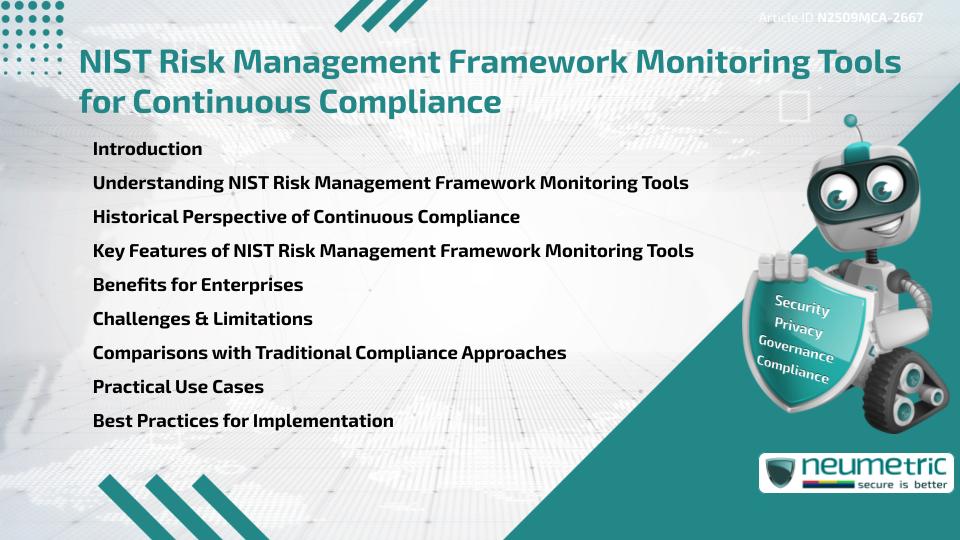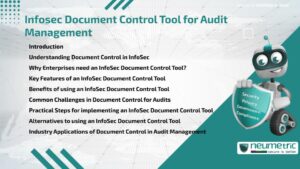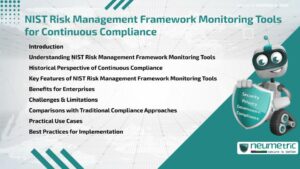Table of Contents
ToggleIntroduction
NIST Risk Management Framework Monitoring Tools help Organisations maintain continuous Compliance by automating Monitoring, tracking Risks & ensuring Regulatory adherence. These tools provide real-time visibility into system security, enabling faster response to Threats & Compliance gaps. By integrating with Governance & Risk processes, they empower enterprises to streamline Compliance activities & strengthen IT Governance. This article explores the history, features, benefits, challenges, comparisons & Best Practices of using NIST Risk Management Framework Monitoring Tools.
Understanding NIST Risk Management Framework Monitoring Tools
NIST Risk Management Framework Monitoring Tools are software solutions designed to support the National Institute of Standards & Technology Risk Management Framework [RMF]. They enable Organisations to implement, monitor & assess Security Controls continuously. Instead of relying on periodic assessments, these tools allow teams to evaluate Compliance in real time, reducing Risk exposure.
Historical Perspective of Continuous Compliance
In the past, Compliance efforts were periodic & reactive. Organisations conducted annual or quarterly Audits, leaving gaps between assessments. This approach often resulted in delayed responses to Vulnerabilities. The rise of Continuous Monitoring Tools, supported by the NIST RMF, shifted Compliance practices toward proactive & ongoing evaluation. This transformation aligns with modern security needs in dynamic IT environments.
Key Features of NIST Risk Management Framework Monitoring Tools
Core features of NIST Risk Management Framework Monitoring Tools include:
- Automated Control Monitoring
- Real-time Alerts & Reporting
- Integration with Risk & Governance platforms
- Centralised dashboards for Compliance tracking
- Continuous Vulnerability Assessment
These features help Organisations maintain Compliance while adapting quickly to new Risks.
Benefits for Enterprises
Enterprises using NIST Risk Management Framework Monitoring Tools benefit from:
- Improved visibility into Compliance status
- Faster identification & remediation of Security Gaps
- Reduced manual workload through automation
- Enhanced alignment with frameworks such as FISMA & FedRAMP
- Stronger Audit readiness with centralised data
Challenges & Limitations
Despite their value, NIST Risk Management Framework Monitoring Tools pose challenges. Implementation can be complex & resource-intensive. Smaller Organisations may find costs difficult to justify. Additionally, over-reliance on automation may lead to oversight of context-specific Risks that require human judgment.
Comparisons with Traditional Compliance Approaches
Traditional Compliance approaches rely on static Audits & manual Reporting. These methods are often time-consuming & prone to human error. In contrast, NIST Risk Management Framework Monitoring Tools deliver automation, real-time oversight & scalability. While traditional methods may still serve small Organisations with limited needs, Continuous Monitoring Tools offer far greater efficiency & accuracy.
Practical Use Cases
NIST Risk Management Framework Monitoring Tools are widely used in Government, Healthcare & Finance. Federal agencies adopt them to comply with FISMA requirements, while enterprises in regulated industries apply them to achieve Certifications & strengthen Security Posture. They are particularly effective in environments handling Sensitive or Classified data.
Best Practices for Implementation
Organisations adopting NIST Risk Management Framework Monitoring Tools should:
- Start with a Compliance gap Assessment
- Align tool selection with organisational objectives
- Involve Stakeholders across IT, Compliance & Leadership
- Provide training for Users & Administrators
- Establish continuous feedback & performance reviews
These practices ensure successful integration & sustained Compliance improvements.
Conclusion
NIST Risk Management Framework Monitoring Tools provide Organisations with the ability to maintain continuous Compliance, reduce Risks & respond faster to Threats. By automating monitoring & centralising Compliance data, enterprises can enhance Governance & Security.
Takeaways
- NIST Risk Management Framework Monitoring Tools enable real-time Compliance tracking.
- They reduce manual effort & improve Audit readiness.
- Adoption requires planning, resources & Stakeholder involvement.
- Compared to traditional methods, they deliver greater efficiency & accuracy.
FAQ
What are NIST Risk Management Framework Monitoring Tools?
They are software platforms that support Continuous Compliance by automating Monitoring of Security Controls aligned with the NIST RMF.
Why are these tools important?
They provide real-time visibility, reduce manual effort & improve Compliance readiness for Audits & Certifications.
How do they differ from traditional Compliance methods?
Traditional methods rely on periodic Audits, while these tools provide ongoing Monitoring & automated Reporting.
Which industries benefit most from these tools?
Government, Healthcare & Finance sectors that require strict Compliance benefit significantly.
What challenges come with adoption?
Challenges include high Costs, Integration complexity & the Risk of overlooking context-specific security issues.
What features should Organisations prioritise?
Real-time alerts, automated monitoring, integration capabilities & centralised dashboards.
Can small Organisations use these tools effectively?
Yes, but they may face cost & resource barriers that require tailored adoption strategies.
How can Organisations ensure successful implementation?
By assessing Compliance gaps, involving Stakeholders, Training teams & continuously reviewing performance.
Need help for Security, Privacy, Governance & VAPT?
Neumetric provides organisations the necessary help to achieve their Cybersecurity, Compliance, Governance, Privacy, Certifications & Pentesting needs.
Organisations & Businesses, specifically those which provide SaaS & AI Solutions in the Fintech, BFSI & other regulated sectors, usually need a Cybersecurity Partner for meeting & maintaining the ongoing Security & Privacy needs & requirements of their Enterprise Clients & Privacy conscious Customers.
SOC 2, ISO 27001, ISO 42001, NIST, HIPAA, HECVAT, EU GDPR are some of the Frameworks that are served by Fusion – a SaaS, multimodular, multitenant, centralised, automated, Cybersecurity & Compliance Management system.
Neumetric also provides Expert Services for technical security which covers VAPT for Web Applications, APIs, iOS & Android Mobile Apps, Security Testing for AWS & other Cloud Environments & Cloud Infrastructure & other similar scopes.
Reach out to us by Email or filling out the Contact Form…





